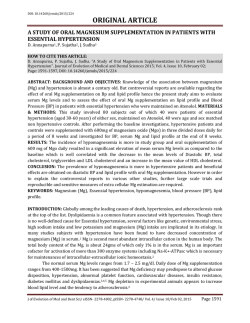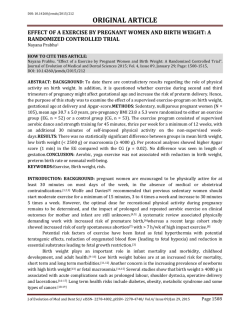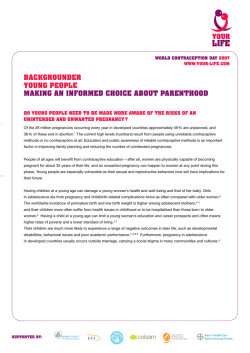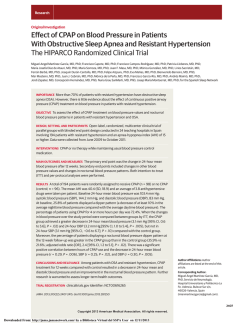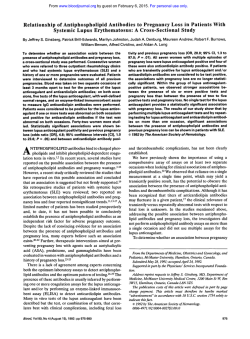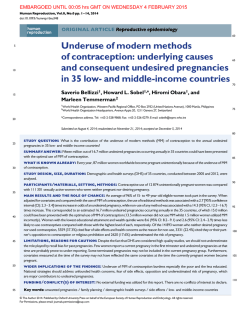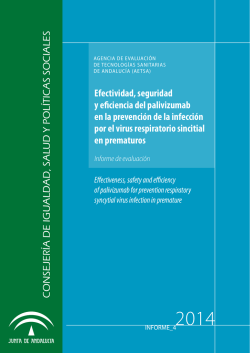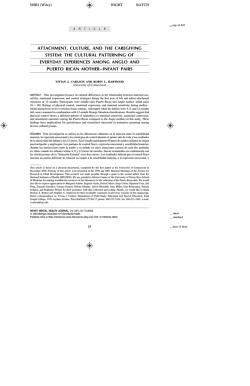
PDF - New England Journal of Medicine
new england journal of medicine The established in 1812 January 29, 2015 vol. 372 no. 5 Less-Tight versus Tight Control of Hypertension in Pregnancy Laura A. Magee, M.D., Peter von Dadelszen, M.B., Ch.B., D.Phil., Evelyne Rey, M.D., Susan Ross, M.B.A., Ph.D., Elizabeth Asztalos, M.D., Kellie E. Murphy, M.D., Jennifer Menzies, M.Sc., Johanna Sanchez, M.I.P.H., Joel Singer, Ph.D., Amiram Gafni, D.Sc., Andrée Gruslin, M.D.,* Michael Helewa, M.D., Eileen Hutton, Ph.D., Shoo K. Lee, M.D., Ph.D., Terry Lee, Ph.D., Alexander G. Logan, M.D., Wessel Ganzevoort, M.D., Ph.D., Ross Welch, M.B., B.S., D.A., M.D., Jim G. Thornton, M.B., Ch.B., M.D., and Jean‑Marie Moutquin, M.D. a bs t r ac t BACKGROUND The effects of less-tight versus tight control of hypertension on pregnancy complications are unclear. METHODS We performed an open, international, multicenter trial involving women at 14 weeks 0 days to 33 weeks 6 days of gestation who had nonproteinuric preexisting or gestational hypertension, office diastolic blood pressure of 90 to 105 mm Hg (or 85 to 105 mm Hg if the woman was taking antihypertensive medications), and a live fetus. Women were randomly assigned to less-tight control (target diastolic blood pressure, 100 mm Hg) or tight control (target diastolic blood pressure, 85 mm Hg). The composite primary outcome was pregnancy loss or high-level neonatal care for more than 48 hours during the first 28 postnatal days. The secondary outcome was serious maternal complications occurring up to 6 weeks post partum or until hospital discharge, whichever was later. The authors’ affiliations are listed in the Appendix. Address reprint requests to Dr. Magee at the BC Women’s Hospital and Health Centre, 4500 Oak St., Van‑ couver, BC V6H 3N1, Canada, or at LMagee@c w.bc.ca. *Deceased. Dr. Magee represents the Control of Hy‑ pertension in Pregnancy Study (CHIPS; ClinicalTrials.gov number, NCT01192412), of which she is the principal investigator; additional CHIPS investigators are listed in the Supplementary Appendix, available at NEJM.org. N Engl J Med 2015;372:407-17. DOI: 10.1056/NEJMoa1404595 Copyright © 2015 Massachusetts Medical Society. RESULTS Included in the analysis were 987 women; 74.6% had preexisting hypertension. The primary-outcome rates were similar among 493 women assigned to less-tight control and 488 women assigned to tight control (31.4% and 30.7%, respectively; adjusted odds ratio, 1.02; 95% confidence interval [CI], 0.77 to 1.35), as were the rates of serious maternal complications (3.7% and 2.0%, respectively; adjusted odds ratio, 1.74; 95% CI, 0.79 to 3.84), despite a mean diastolic blood pressure that was higher in the less-tight-control group by 4.6 mm Hg (95% CI, 3.7 to 5.4). Severe hypertension (≥160/110 mm Hg) developed in 40.6% of the women in the less-tight-control group and 27.5% of the women in the tight-control group (P<0.001). CONCLUSIONS We found no significant between-group differences in the risk of pregnancy loss, high-level neonatal care, or overall maternal complications, although less-tight control was associated with a significantly higher frequency of severe maternal hypertension. (Funded by the Canadian Institutes of Health Research; CHIPS Current Controlled Trials number, ISRCTN71416914; ClinicalTrials.gov number, NCT01192412.) n engl j med 372;5 nejm.org January 29, 2015 407 The n e w e ng l a n d j o u r na l A lmost 10% of pregnant women have hypertension; hypertension is preexisting in 1%, gestational hypertension without proteinuria develops in 5 to 6%, and preeclampsia develops in 2%.1 Preexisting hypertension and gestational hypertension before 34 weeks are associated with an increased risk of perinatal and maternal complications.2-4 Blood-pressure targets for women with nonsevere hypertension during pregnancy are much debated. Relevant randomized, controlled trials have been small and of moderate or poor quality; tight control (the use of antihypertensive therapy to normalize blood pressure) has been associated with maternal benefits (e.g., a decrease in the frequency of severe hypertension and possibly in the rate of antenatal hospitalization)5,6 but sometimes, though not consistently, with perinatal risks (e.g., poor fetal growth and well-being).7-9 International guidelines for nonsevere hypertension during pregnancy recommend treatment goals consistent with either less-tight control (blood pressure that is higher than normal but not severely elevated) or tight control.10-13 The Control of Hypertension in Pregnancy Study (CHIPS) was designed to compare less-tight control with tight control of nonproteinuric, nonsevere hypertension in pregnancy with respect to perinatal and maternal outcomes. Me thods Study Design and Oversight CHIPS was an open, multicenter, international, randomized, controlled trial. The study was approved by the research ethics board at the University of British Columbia (the coordinating center) and at all study sites, and the protocol is available with the full text of this article at NEJM.org. There was no commercial sponsorship. The fifth and 15th authors assume responsibility for the accuracy and completeness of data reporting, and the first and ninth authors vouch for the fidelity of the analyses to the protocol. All study participants provided written, informed consent. Women were included if they had nonsevere, nonproteinuric preexisting hypertension or gestational hypertension; a diastolic blood pressure of 90 to 105 mm Hg if they were not receiving antihypertensive therapy, or 85 to 105 mm Hg if they were receiving such treatment; and a live singleton fetus at 14 weeks 0 days to 33 weeks 6 days 408 of m e dic i n e of gestation (determined in most cases by early pregnancy ultrasound examination). Preexisting hypertension was defined as diastolic blood pressure of 90 mm Hg or higher before pregnancy or before 20 weeks 0 days of gestation. Gestational hypertension was defined as diastolic blood pressure of 90 mm Hg or higher at 20 weeks or more of gestation.14 Korotkoff phase V was used to determine diastolic blood pressure. Blood-pressure measurements were obtained by a health care professional at least 4 hours apart or at two consecutive outpatient visits, with the second measurement taken within 1 week before randomization. The values of both measurements were required to be elevated. Women were excluded if they had a systolic blood pressure of 160 mm Hg or higher (although they could be included subsequently if the systolic blood pressure was reduced to <160 mm Hg with treatment and they met all other eligibility criteria),14,15 had proteinuria (i.e., ≥0.3 g of protein in a 24-hour urine collection, a urinary protein: creatinine ratio of ≥263 [with protein measured in milligrams per day and creatinine in grams per day], or a urinary dipstick result of ≥2+),14 used an angiotensin-converting–enzyme (ACE) inhibitor at 14 weeks 0 days of gestation or later, had a contraindication to either trial group because of a preexisting condition (e.g., pregestational diabetes or renal disease) or needed to be delivered for maternal or fetal reasons, had a known multiple gestation or a fetus with a major anomaly or chromosomal abnormality, had plans to terminate the pregnancy, or had previously participated in CHIPS. Randomization, which was stratified according to center and type of hypertension (preexisting or gestational), was performed in permuted blocks of random size (2 or 4) by site coordinators at a central site, with the use of a toll-free telephone line (Centre for Mother, Infant, and Child Research, University of Toronto) that was accessible 24 hours a day and backed up by a pager system. The assignment sequence was generated by a programmer who used SAS software, version 9.2 (SAS Institute); the sequences were secured and available only to the system manager, and the telephone line was password protected. Eligible women were randomly assigned in a 1:1 ratio to less-tight control (target diastolic blood pressure, 100 mm Hg) (Fig. S1A in the Supplementary Appendix, available at NEJM.org) or tight n engl j med 372;5 nejm.org January 29, 2015 Control of Hypertension in Pregnancy control (target diastolic blood pressure, 85 mm Hg) (Fig. S1B in the Supplementary Appendix) until delivery, with the goal of a between-group difference in diastolic blood pressure of 5 mm Hg, a difference that was similar to that achieved in our pilot trial.9 We anticipated that the average diastolic blood pressure in the less-tight-control group would be below 100 mm Hg and that the between-group difference in diastolic blood pressure would be less than 15 mm Hg, because most women who have hypertension without coexisting conditions have mild hypertension and would remain off antihypertensive medication after randomization. The study protocol recommended labetalol as the drug of first choice. ACE inhibitors, angiotensin-receptor antagonists, direct renin inhibitors, and atenolol were not permitted before delivery.14,16 No antihypertensive drugs were provided by the study. Standardized measurement of blood pressure was performed in outpatient settings by health professionals who obtained three blood-pressure measurements. The average of the second and third diastolic blood-pressure measurements was considered to be the diastolic blood pressure for that visit17; this information was recorded in a patient-held diary, where potential cointerventions (e.g., clinic visits and fetal ultrasound examinations) were also recorded. Women were seen by their maternity care provider within 4 weeks after randomization, at which time adherence to the recommended algorithm (i.e., actions taken to achieve a target diastolic blood pressure of 100 to 104 mm Hg or 81 to 85 mm Hg) (Fig. S1 in the Supplementary Appendix) and “clinically reasonable” adherence (i.e., actions taken to achieve a diastolic blood pressure 5 mm Hg above or below the target value of 100 mm Hg or 85 mm Hg) were evaluated (Table S2 in the Supplementary Appendix). Thereafter, women were seen according to a schedule determined by their maternity care provider. Data on blood-pressure measurements and cointerventions were collected from the patients’ diaries during meetings (in person or by phone) with the site coordinator (at 14 to 20, 21 to 28, 29 to 33, and 34 to 40 weeks of gestation and at delivery). Outcome data were obtained from maternal and infant charts. At or after 6 weeks post partum and when the baby was at least 36 weeks of corrected postgestational age, a standardized maternal questionnaire was administered once (in person or by phone) by site coordinators to identify postdischarge maternal or neonatal complications. Study Outcomes The primary outcome was a composite of pregnancy loss (defined as miscarriage, ectopic pregnancy, pregnancy termination, stillbirth, or neonatal death) or high-level neonatal care (defined as greater-than-normal newborn care) for more than 48 hours until 28 days of life or until discharge home, whichever was later. The secondary outcome was serious maternal complications occurring up to 6 weeks post partum or until hospital discharge, whichever was later. Serious maternal complications included death, stroke, eclampsia, blindness, uncontrolled hypertension, the use of inotropic agents, pulmonary edema, respiratory failure, myocardial ischemia or infarction, hepatic dysfunction, hepatic hematoma or rupture, renal failure, and transfusion18 (see Table S3 in the Supplementary Appendix for all definitions). The primary and secondary outcomes were adjudicated centrally by an expert committee whose members were unaware of the group assignments and were not involved in the care of patients in the cases under review. Other outcomes included components of the primary and secondary outcomes, measures of fetal growth and newborn complications, and severe hypertension (≥160/110 mm Hg) in the mother. Statistical Analysis We estimated that with a sample size of 514 per group, the study would have 80% power, at a two-tailed alpha level of 0.05, assuming primary outcome rates of 33% in the tight-control group and 25% in the less-tight-control group, a 10% rate of crossover, a 1% loss to follow-up, and two interim analyses,9 as calculated with the chisquare test with the use of East software (Cytel) and the Lan–DeMets spending function with O’Brien–Fleming–type boundaries for early stopping. Analyses were performed according to the intention-to-treat principle. The unit of analysis was the individual woman. The primary outcome and all dichotomous outcomes were analyzed with the use of a mixedeffects logistic-regression model, with adjustment for the stratification factors, the use of any antihypertensive therapy at the time of randomization, prerandomization blood pressure of 160/110 n engl j med 372;5 nejm.org January 29, 2015 409 The n e w e ng l a n d j o u r na l m e dic i n e mm Hg or higher during this pregnancy, gestational diabetes, and any factor with apparent dissimilarity between the groups at baseline.19 The alpha level was set at 0.046 for the primary outcome, on the basis of the Lan–DeMets spending function with O’Brien–Fleming–type boundaries and two interim analyses (with P<0.0002 and P<0.012 used as guidelines by the data and safety monitoring board at the Centre for Mother, Infant, and Child Research for the consideration of early termination of the trial at the first and second interim analyses, respectively). To accommodate the many comparisons made, two-tailed P values of less than 0.01 for the secondary outcomes and less than 0.001 for other outcomes were considered to indicate statistical significance. Exploratory analyses of the primary and secondary outcomes, birth weight less than the 10th percentile,20 severe hypertension, and preeclampsia included interactions between treatment and five prognostic factors from the adjusted logisticregression model, the perinatal mortality ratio of the recruiting country, and clinically reasonable adherence; for these exploratory analyses, the Breslow–Day test of homogeneity was used and P values of less than 0.05 were considered to indicate statistical significance. Blood-pressure measurements after randomization were compared between groups with the use of a mixed-effects logistic-regression model, which accounted for participants having different numbers of observations over a varying time span. The patient was a random effect, and treatment group and time point were fixed effects. sites who were identified as eligible, of whom 496 (56.3%) enrolled and 385 (43.7%) declined enrollment (for the reasons for nonparticipation, see Table S4 in the Supplementary Appendix). After exclusion of the women from one site, 497 women were randomly assigned to less-tight control and 490 to tight control (Fig. 1). Subsequently, 3 women withdrew from the study and 3 women were lost to follow-up before delivery; we have no primary or secondary outcome data for these women (Fig. 1). Thirteen women assigned to less-tight control and 11 women assigned to tight control were reported to have discontinued their assigned blood-pressure treatment before delivery; they were included in the analyses according to their assigned group. Five women in each group were lost to follow-up for the postpartum questionnaire. After enrollment, 8 women in the less-tight-control group and 13 in the tight-control group were found to have been ineligible, but they all remained in the study (Table S5 in the Supplementary Appendix). The characteristics of participants at trial entry are shown in Table 1 and in Table S5 in the Supplementary Appendix. The baseline characteristics of the women were generally similar in the two groups; the number of weeks of gestation at enrollment appeared to be slightly greater in the group assigned to less-tight control than in the group assigned to tight control (prompting the inclusion of weeks of gestation in the adjusted logistic-regression model for all outcomes). R e sult s The frequency of adherence to the recommended algorithm for management was similar in the lesstight-control group and the tight-control group (74.1% and 73.4%, respectively; P = 0.81), but the frequency of clinically reasonable adherence was slightly lower in the less-tight-control group (76.6% vs. 82.0%, P = 0.04). Adherence could not be assessed for 25 women (10 in the less-tight-control group and 15 in the tight-control group) who did not have an office visit or a clinic visit after randomization. Few women (2 in the less-tight-control group and 1 in the tight-control group) had their medication adjusted for reasons other than blood-pressure control. From randomization until delivery, blood pressure was higher among women in the less-tightcontrol group than among those in the tight-con- Enrollment and Randomization Among 111 active sites, 95 sites in 16 countries enrolled at least one woman (1030 recruits from March 26, 2009, to August 2, 2012). A total of 519 women were randomly assigned to less-tight control and 511 to tight control of diastolic blood pressure. One site (in which 43 women were enrolled) was excluded before the analyses on the advice of the CHIPS steering committee and the data and safety monitoring board owing to concerns about informed consent and data integrity. At the remaining 94 sites, the median number of annual deliveries was 3700 (interquartile range, 2650 to 5000). A total of 45 sites (47.9%) reported detailed information on the 881 women at their 410 of Postrandomization Blood Pressure, Adherence, and Cointerventions n engl j med 372;5 nejm.org January 29, 2015 Control of Hypertension in Pregnancy 1030 Patients underwent randomization 519 Women (519 fetuses) were assigned to less-tight control 511 Women (511 fetuses) were assigned to tight control 22 Were excluded 21 Were excluded 497 Women (497 fetuses) were included in the analysis 490 Women (490 fetuses) were included in the analysis 1 Withdrew before receiving intervention and did not consent to use of outcome data 497 Women (497 fetuses) underwent less-tight control 489 Women (489 fetuses) underwent tight control 2 Women withdrew after initial participation 2 Women were lost to follow-up 1 Woman was lost to follow-up 493 Fetuses or neonates were included in the primary-outcome analysis 488 Fetuses or neonates were included in the primary-outcome analysis 493 Women were included in the secondary-outcome analysis 488 Women were included in the secondary-outcome analysis Figure 1. Enrollment and Randomization. Data from 45 sites (881 women) indicated that 385 eligible women (43.7%) did not undergo randomization. A total of 16 additional centers were active but did not recruit any women into the study; these centers were in Brazil (3 centers), Canada (1 center), the Netherlands (4 centers), the United Kingdom (7 centers), and the United States (1 center). There was one active center (with no recruits) in Equatorial Guinea that was deactivated when the site in‑ vestigator moved. One site (which had enrolled 43 women) was excluded owing to concern about informed consent and data integrity. trol group, by a mean of 5.8 mm Hg systolic (95% confidence interval [CI], 4.5 to 7.0; 138.8±0.5 mm Hg vs. 133.1±0.5 mm Hg, P<0.001) and 4.6 mm Hg diastolic (95% CI, 3.7 to 5.4; 89.9±0.3 mm Hg vs. 85.3±0.3 mm Hg, P<0.001). Antihypertensive medication was taken after randomization by fewer women in the less-tightcontrol group than in the tight-control group before delivery (73.4% vs. 92.6%, P<0.001) and after delivery (65.5% vs. 78.3%, P<0.001) (Table S6 in the Supplementary Appendix). Among women receiving antihypertensive therapy, labetalol was the most commonly used agent overall (68.9% and 68.8% in the two groups, respectively). There were four protocol violations (four women at different sites) involving postrandomization, predelivery use of atenolol. Otherwise, women in the lesstight-control and tight-control groups received similar treatment (Table S6 in the Supplementary Appendix). n engl j med 372;5 nejm.org January 29, 2015 411 The n e w e ng l a n d j o u r na l of m e dic i n e Table 1. Baseline Characteristics at Enrollment.* Characteristic Maternal age at expected date of delivery — yr Less-Tight Control (N = 497) Tight Control (N = 490) 34.0±5.7 33.7±5.8 Body-mass index — no./total no. (%)† <18.5 1/493 (0.2) 2/485 (0.4) 18.5–24.9 116/493 (23.5) 112/485 (23.1) 25.0–29.9 131/493 (26.6) 135/485 (27.8) ≥30.0 245/493 (49.7) 236/485 (48.7) Cigarette smoking during this pregnancy — no. (%) 35 (7.0) 28 (5.7) 161 (32.4) 168 (34.3) 23.7±6.3 24.2±6.3 Preexisting hypertension 371 (74.6) 365 (74.5) Gestational hypertension 126 (25.4) 125 (25.5) Prior blood pressure ≥160 mm Hg systolic or ≥110 mm Hg diastolic during this pregnancy — no. (%) 82 (16.5) 59 (12.0) Antihypertensive medication at enrollment — no. (%) 279 (56.1) 287 (58.6) 140.4±9.7 139.7±9.8 Nulliparous — no. (%) Weeks of gestation Type of nonproteinuric hypertension — no. (%) Blood pressure within 1 wk before randomization — mm Hg Systolic Diastolic Currently monitoring blood pressure at home — no. (%) Gestational diabetes at enrollment — no. (%) 92.6±4.8 92.2±5.2 185 (37.2) 194 (39.6) 32 (6.4) 31 (6.3) *Plus–minus values are means ±SD. There were no significant differences between the groups except with respect to pri‑ or blood pressure of 160 mm Hg or higher systolic or 110 mm Hg or higher diastolic during this pregnancy (P = 0.049). †Body-mass index is the weight in kilograms divided by the square of the height in meters. Outcomes The median duration of study participation before delivery was 12.1 weeks (interquartile range, 6.4 to 18.8) in the less-tight-control group and 11.4 weeks (interquartile range, 6.6 to 19.0) in the tight-control group (P = 0.75). The gestational age at delivery and the frequency of cesarean delivery did not differ significantly between the groups (Table S7 in the Supplementary Appendix). Spontaneous vaginal delivery was more common in the less-tight-control group, but the P value of 0.03 did not meet the prespecified level of significance (P<0.001) for the “other outcomes” category. The frequency of the primary outcome — pregnancy loss or high-level neonatal care for more than 48 hours — did not differ significantly between the groups (Table 2, and Table S8 in the Supplementary Appendix). Most perinatal deaths were stillbirths. Most high-level neonatal care for more than 48 hours was related to com412 plications of prematurity. There were no significant between-group differences with respect to other perinatal outcomes, including the proportion of newborns who were small for gestational age and the frequency of respiratory complications and treatment. The frequency of the secondary outcome — serious complications (including death) — was also similar in the two groups (Table 3, and Table S9 in the Supplementary Appendix); given the low event rate, adjustment could be made only for hypertension type (preexisting vs. gestational) and previous severe hypertension. There were no maternal deaths. The most common maternal complication was the receipt of blood products. The frequency of abruption did not differ significantly between the groups. Most serious maternal complications occurred among women with preeclampsia (15 of 18 women in the lesstight-control group and 6 of 10 in the tight-control group). The frequency of severe hypertension n engl j med 372;5 nejm.org January 29, 2015 Control of Hypertension in Pregnancy Table 2. Primary and Other Perinatal Outcomes.* Less-Tight Control (N = 493) Variable Primary outcome — no. (%) Pregnancy loss — no. (%) Tight Control (N = 488) 155 (31.4) 150 (30.7) 1.02 (0.77–1.35) 15 (3.0) 13 (2.7) 1.14 (0.53–2.45) Miscarriage 0 1 (0.2) Ectopic pregnancy 0 0 Elective termination‡ 1 (0.2) 1 (0.2) Perinatal death 14 (2.8) 11 (2.3) Stillbirth 12 (2.4) 7 (1.4) 2 (0.4) 4 (0.8) Neonatal death High-level neonatal care for >48 hr — no./total no. (%)§ Adjusted Odds Ratio (95% CI)† 1.25 (0.56–2.81) 141/480 (29.4) 139/479 (29.0) 36.8±3.4 37.2±3.1 Birth weight <10th percentile 79/491 (16.1) 96/488 (19.7) 0.78 (0.56–1.08) Birth weight <3rd percentile 23/491 (4.7) 26/488 (5.3) 0.92 (0.51–1.63) Clinical respiratory problem 82/480 (17.1) 67/479 (14.0) 1.19 (0.83–1.71) Administration of oxygen beyond the first 10 min of life 34/479 (7.1) 25/477 (5.2) 1.24 (0.72–2.14) Ventilatory support (with or without intuba‑ tion) beyond the first 10 min of life 35/478 (7.3) 38/479 (7.9) 0.86 (0.53–1.40) Use of surfactant 28/480 (5.8) 26/479 (5.4) 0.97 (0.55–1.69) 40/480 (8.3) 40/479 (8.4) 0.96 (0.60–1.52) Gestational age at delivery — wk 1.00 (0.75–1.33) Small-for-gestational-age newborns — no./total no. (%)¶ Other perinatal outcomes of liveborn infants Respiratory complications — no./total no. (%) At least one serious neonatal complication — no./total no. (%)‖ *Plus–minus values are means ±SD. The primary outcome was a composite of pregnancy loss or high-level neonatal care for more than 48 hours. There were no significant differences between the groups. †The mixed-effects logistic-regression model was adjusted for stratification factors (type of hypertension [preexisting vs. gestational] and center), the use of any antihypertensive therapy at randomization, previous blood pressure of 160/110 mm Hg or higher during this pregnancy, gestational diabetes, and weeks of gestation at randomization. ‡The reasons specified for elective termination were severe preeclampsia (one patient in the less-tight-control group, previability at 22 weeks 0 days of gestation) and fetal anomaly (one patient in the tight-control group, at 23 weeks 4 days of gestation). §Among liveborn infants admitted for high-level neonatal care for more than 48 hours, four infants died (one born to a mother in the less-tight-control group and three born to mothers in the tight-control group). ¶Birth-weight percentiles were determined for gestational age (22 to 43 weeks) and sex.17 Two babies were born after 22 weeks of gestation (both to mothers in the less-tight-control group), with birth weights of 180 g and 426 g; they were excluded from the analysis. ‖Serious neonatal complications were severe respiratory distress, sepsis in the first 48 hours of life, bronchopulmonary dysplasia, severe retinopathy of prematurity, central nervous system complications, and necrotizing enterocolitis (see Table S3 in the Supplementary Appendix for definitions). was higher among women in the less-tight-control group than among those in the tight-control group (P<0.001) (Fig. 2, Table 3, and Table S9 in the Supplementary Appendix); however, the distribution of observed systolic and diastolic bloodpressure values (P = 0.63 and P = 0.72, respectively) was similar between the two groups, illustrating that the excess risk of severe hypertension among women in the less-tight-control group was not restricted to values just above the threshold. The frequency of a platelet count less than 100×109 per liter or an elevated liver-enzyme level with associ- n engl j med 372;5 nejm.org January 29, 2015 413 The n e w e ng l a n d j o u r na l of m e dic i n e Table 3. Secondary and Other Maternal Outcomes.* Less-Tight Control (N = 493) Variable Serious maternal complications — no. (%)‡ Tight Control (N = 488) 18 (3.7) 10 (2.0) Uncontrolled hypertension 0 0 Transient ischemic attack or stroke 0 1 (0.2) Pulmonary edema 2 (0.4) 1 (0.2) Renal failure 0 1 (0.2) Transfusion§ Adjusted Odds Ratio (95% CI)† 1.74 (0.79–3.84) 16 (3.2) 8 (1.6) Placental abruption — no. (%) 11 (2.2) 11 (2.3) 0.94 (0.40–2.21) Severe hypertension — no. (%) 200 (40.6) 134 (27.5) 1.80 (1.34–2.38) Preeclampsia — no./total no. (%) 241/493 (48.9) 223/488 (45.7) 1.14 (0.88–1.47) Defined only by new proteinuria¶ 148/493 (30.0) 132/488 (27.0) 1.08 (0.74–1.59) At least one symptom of preeclampsia‖ 171/493 (34.7) 156/488 (32.0) 1.11 (0.84–1.46) Abnormal laboratory test results Platelet count <100×109/liter 21/493 (4.3) 8/488 (1.6) 2.63 (1.15–6.05) Elevated AST or ALT level, with symptoms 21/492 (4.3) 9/488 (1.8) 2.33 (1.05–5.16) Elevated LDH level, with symptoms 16/491 (3.3) 9/488 (1.8) 1.78 (0.77–4.11) 9/493 (1.8) 2/488 (0.4) 4.35 (0.93–20.35) 0 1/488 (0.2) HELLP syndrome** Serum creatinine level >2.3 mg/dl *The secondary outcome was serious maternal complications occurring up to 6 weeks post partum or until hospital discharge, whichever was later. There were no significant differences in other maternal outcomes between the groups except with respect to severe hypertension (blood pressure, ≥160 mm Hg systolic or ≥110 mm Hg diastolic; P<0.001). There were notable but not significant between-group differences with respect to platelet count (P<0.05) and elevated aspartate aminotransferase (AST) or alanine aminotransferase (ALT) levels with symptoms (P<0.05). To convert the value for serum creatinine to micromoles per liter, multiply by 88.4. HELLP denotes hemolysis, elevated liver-enzyme levels, and a low platelet count; and LDH lactate dehydrogenase. †The mixed-effects logistic-regression model was adjusted for stratification factors (type of hypertension [preexisting or gestational] and center), the use of any antihypertensive therapy at randomization, previous blood pressure of 160/110 mm Hg or higher during this pregnancy, gestational diabetes, and weeks of gestation at randomization. ‡A woman could have more than one complication. No woman died or had any of the following complications: ec‑ lampsia, blindness, respiratory failure, hepatic dysfunction, hepatic hematoma or rupture, myocardial ischemia or in‑ farction, or the required use of inotropic agents. §Antepartum transfusion was received by one woman in the tight-control group (she also received a postpartum trans‑ fusion). Postpartum transfusion was administered for anemia not otherwise specified (four women in the less-tightcontrol group and four in the tight-control group), postpartum hemorrhage (five women in the less-tight-control group and two in the tight-control group), HELLP syndrome (three women in the less-tight-control group), operative blood loss (three women in the less-tight-control group), and placental abruption (one woman in the less-tight-con‑ trol group and two in the tight-control group). ¶Proteinuria was determined by the highest amount recorded by whichever method was used (i.e., ≥0.3 g of protein in a 24-hour urine collection, a urinary protein:creatinine ratio of ≥263 [with protein measured in milligrams per day and creatinine in grams per day], or a urinary dipstick result of ≥2+). ‖Examples of symptoms of preeclampsia are headache (persistent, new, or unusual), visual disturbances, chest pain, dyspnea, severe nausea or vomiting, and persistent right-upper-quadrant or epigastric abdominal pain. **The HELLP syndrome was defined as a platelet count less than 100×109 per liter and either elevated AST or ALT lev‑ els in association with symptoms or an elevated LDH level in association with symptoms. ated symptoms was higher among women in the less-tight-control group than among those in the tight-control group (P<0.05 for each comparison) but the difference did not meet the criterion for significance (i.e., P<0.001). Results for the primary and secondary outcomes were similar regardless 414 of the type of hypertension, whether antihypertensive therapy was being used at randomization, whether the mother had gestational diabetes, the perinatal mortality ratio of the recruiting country (Fig. S3 and Table S10 in the Supplementary Appendix), and whether there was clinically rea- n engl j med 372;5 nejm.org January 29, 2015 Control of Hypertension in Pregnancy sonable adherence to the management algorithm (Fig. S2 in the Supplementary Appendix). A Systolic Blood Pressure Discussion Tight control (N=488) Women (%) 20 15 10 5 0 160–169 170–179 ≥180 mm Hg B Diastolic Blood Pressure Less-tight control (N=493) 25 Tight control (N=488) 20 Women (%) This randomized trial showed that less-tight control of maternal hypertension in pregnancy as compared with tight control resulted in no significant difference in the risk of adverse perinatal outcomes, as assessed by the rates of perinatal death or high-level neonatal care for more than 48 hours (our primary outcome). On the basis of the 95% confidence interval around the risk estimate and an event rate of 30.4% in the tightcontrol group, the results are compatible with no more than a 5.2 percentage-point decrease or 6.6 percentage-point increase in the rate of the primary outcome with less-tight as compared with tight control. Less-tight (vs. tight) control did not significantly increase the risk of overall serious maternal complications (our secondary outcome), although our findings are compatible with anywhere from a 0.7 percentage-point decrease to a 4.0 percentage-point increase in the rate of this outcome. Less-tight control was associated with a higher risk of severe maternal hypertension than was tight control. Although less-tight control was also associated with a higher risk of a platelet count less than 100×109 per liter and elevated liverenzyme levels in association with symptoms, the P values for these associations did not reach the prespecified level of significance for “other outcomes.” Our trial is substantially larger than previous trials that have examined the effects of lower versus higher blood-pressure targets during pregnancy (with previous trials having randomly assigned women to antihypertensive therapy or placebo or no treatment).5 With respect to the mothers, our findings are consistent with a metaanalysis of previous trials (29 trials involving 3350 women) that showed that less-tight versus tight control increases the incidence of severe maternal hypertension (but not preeclampsia).5 Severe hypertension is a risk factor for acute stroke during and outside of pregnancy.15,21 The rates of severe hypertension were higher in the current study than in some previous trials (in which the rate was approximately 20% in the placebo or no-therapy group),5 even though almost half the women in CHIPS performed blood-pressure moni- Less-tight control (N=493) 25 15 10 5 0 110–119 120–129 ≥130 mm Hg Figure 2. Blood-Pressure Values among Women with Severe Hypertension. Panel A shows the percentage of women with systolic blood pressure of 160 mm Hg or higher, and Panel B shows the percentage of women with diastolic blood pressure of 110 mm Hg or higher. I bars represent 95% confidence intervals. toring at home. CHIPS may have identified women with true hypertension; the rates of severe hypertension were consistent with those in trials that recruited women with hypertension early in the second trimester, when blood pressure during pregnancy is lowest.6,9 Meta-analyses of previous randomized, controlled trials have suggested that lower blood pressure (achieved with the use of antihypertensive therapy) versus higher blood pressure may result in lower birth weight and a heightened risk of small-for-gestational-age newborns.7,8 In contrast, another meta-analysis of randomized, n engl j med 372;5 nejm.org January 29, 2015 415 The n e w e ng l a n d j o u r na l controlled trials involving pregnant women showed that tight control with beta-blockers (including labetalol) was associated with fewer neonatal respiratory complications, but this was subject to potential publication bias.16 Our findings of no significant between-group differences in the primary or other perinatal outcomes do not support these potential benefits or risks of less-tight versus tight control. Before the start of the trial, the target difference in blood pressure was 5 mm Hg. We achieved mean differences of 5.8 mm Hg in systolic blood pressure and 4.6 mm Hg in diastolic blood pressure, differences that were consistent with those achieved in trials involving nonpregnant participants in which lower versus “standard” targets were evaluated.22 A limitation of our trial was that we included women with either preexisting or gestational hypertension, but results for the primary and secondary outcomes were similar for each hypertension type. Our primary and secondary outcomes included some causes of pregnancy loss (miscarriage and elective termination) and some interventions for high-level neonatal care that were not expected to be associated with maternal bloodpressure control; however, these causes and interventions (including no ectopic pregnancies in either group) were infrequent and were balanced of m e dic i n e between the groups. Although labetalol was considered to be the antihypertensive agent of choice in this study, it was used by only two thirds of the women who received antihypertensive medication after randomization. We did not collect information on common adverse effects of antihypertensive medications, but few women had medication adjusted for reasons other than blood-pressure control. In a meta-analysis of randomized, controlled trials of antihypertensive therapy in pregnancy, only 3.4% of women treated with antihypertensive agents changed drugs because of maternal side effects.5 In summary, we found no significant differences in the rates of major adverse perinatal outcomes or overall serious maternal complications in association with less-tight versus tight control of blood pressure. However, less-tight control was associated with a higher rate of severe maternal hypertension. Supported by a grant (MCT 87522) from the Canadian Institutes of Health Research. Dr. von Dadelszen reports receiving consulting fees and inkind support of research from Alere International related to preeclampsia and fetal growth restriction through the provision of Triage PlGF cartridges. No other potential conflict of interest relevant to this article was reported. Disclosure forms provided by the authors are available with the full text of this article at NEJM.org. This manuscript is dedicated to the memory of our dear friend and colleague, Dr. Andrée Gruslin. We thank all the women who participated in CHIPS. Appendix The authors’ affiliations are as follows: the Departments of Medicine (L.A.M.) and Obstetrics and Gynaecology (L.A.M., P.D., J.M.), the School of Population and Public Health (L.A.M., P.D., J. Singer), and the Centre for Health Evaluation and Outcome Sciences, Providence Health Care Research Institute (J. Singer, T.L.), University of British Columbia, Vancouver; the Departments of Medicine and Obstetrics and Gynaecology, University of Montreal, Montreal (E.R.); the Department of Obstetrics and Gynaecology, University of Alberta, Edmonton (S.R.); the Departments of Obstetrics and Gynaecology (E.A., K.E.M.), Paediatrics (E.A., S.K.L.), and Medicine (A.G.L.) and the Centre for Mother, Infant, and Child Research, Sunnybrook Research Institute (E.A., K.E.M., J. Sanchez), University of Toronto, Toronto; the Departments of Clinical Epidemiology and Biostatistics (A. Gafni) and Obstetrics and Gynaecology (E.H.), McMaster University, Hamilton, ON; the Department of Obstetrics and Gynaecology, University of Ottawa, Ottawa (A. Gruslin); the Department of Obstetrics and Gynaecology, University of Manitoba, Winnipeg (M.H.); and the Department of Obstetrics and Gynaecology, Université de Sherbrooke, Sherbrooke, QC (J.-M.M.) — all in Canada; the Department of Obstetrics and Gynecology, University of Amsterdam, Amsterdam (W.G.); and the Department of Obstetrics and Gynaecology, Derriford Hospital, Devon (R.W.), and the Department of Obstetrics and Gynaecology, University of Nottingham, Nottingham (J.G.T.) — both in the United Kingdom. References 1. Saftlas AF, Olson DR, Franks AL, Atrash AK, Pokras R. Epidemiology of preeclampsia and eclampsia in the United States, 1979–1986. Am J Obstet Gynecol 1990;163:460-5. 2. Magee LA, Abalos E, von Dadelszen P, Sibai B, Walkinshaw SA. Control of hypertension in pregnancy. Curr Hypertens Rep 2009;11:429-36. 3. Steegers EA, von Dadelszen P, Duvekot JJ, Pijnenborg R. Pre-eclampsia. Lancet 2010;376:631-44. 416 4. Brown MA, Buddle ML. The impor- tance of nonproteinuric hypertension in pregnancy. Hypertens Pregnancy 1995;14: 57-65. 5. Abalos E, Duley L, Steyn DW. Antihypertensive drug therapy for mild to moderate hypertension during pregnancy. Cochrane Database Syst Rev 2014; 2: CD002252. 6. El Guindy AA, Nabhan AF. A randomized trial of tight vs. less tight control of mild essential and gestational hypertension in pregnancy. J Perinat Med 2008;36:413-8. 7. von Dadelszen P, Magee LA. Fall in mean arterial pressure and fetal growth restriction in pregnancy hypertension: an updated metaregression analysis. J Obstet Gynaecol Can 2002;24:941-5. 8. von Dadelszen P, Ornstein MP, Bull SB, Logan AG, Koren G, Magee LA. Fall in mean arterial pressure and fetal growth restriction in pregnancy hypertension: a meta-analysis. Lancet 2000;355:87-92. n engl j med 372;5 nejm.org January 29, 2015 Control of Hypertension in Pregnancy 9. Magee LA, von Dadelszen P, Chan S, et al. The Control of Hypertension In Pregnancy Study pilot trial. BJOG 2007; 114(6):770-e13-20. 10. National Institute for Health and Care Excellence. Hypertension in pregnancy: the management of hypertensive disorders during pregnancy. NICE clinical guideline 107, August 2010 (https://w ww .nice.org.uk/g uidance/cg107). 11.American College of Obstetricians and Gynecologists. Hypertension in pregnancy: report of the American College of Obstetricians and Gynecologists’ Task Force on Hypertension in Pregnancy. Obstet Gynecol 2013;122:1122-31. 12.Magee LA, Pels A, Helewa M, Rey E, von Dadelszen P. Diagnosis, evaluation, and management of the hypertensive disorders of pregnancy: executive summary. J Obstet Gynaecol Can 2014;36:416-41. 13.Magee LA, Pels A, Helewa M, Rey E, von Dadelszen P. Diagnosis, evaluation and management of the hypertensive disorders of pregnancy. Pregnancy Hypertens 2014;4:105-45. 14.Magee LA, Helewa M, Moutquin JM, von Dadelszen P. Diagnosis, evaluation, and management of the hypertensive disorders of pregnancy. J Obstet Gynaecol Can 2008;30:Suppl:S1-S48. 15. Martin JN Jr, Thigpen BD, Moore RC, Rose CH, Cushman J, May W. Stroke and severe preeclampsia and eclampsia: a paradigm shift focusing on systolic blood pressure. Obstet Gynecol 2005;105:246-54. 16.Magee LA, Duley L. Oral beta-blockers for mild to moderate hypertension during pregnancy. Cochrane Database Syst Rev 2003;3:CD002863. 17. The 2013 Canadian Hypertension Education Program Recommendations (https://w ww.hypertension.ca/en/chep). 18.von Dadelszen P, Payne B, Li J, et al. Prediction of adverse maternal outcomes in pre-eclampsia: development and vali- dation of the fullPIERS model. Lancet 2011;377:219-27. 19. Thompson SG, Warn DE, Turner RM. Bayesian methods for analysis of binary outcome data in cluster randomized trials on the absolute risk scale. Stat Med 2004; 23:389-410. 20.Kramer MS, Platt RW, Wen SW, et al. A new and improved population-based Canadian reference for birth weight for gestational age. Pediatrics 2001;108(2):E35. 21. Lewis G, ed. The confidential enquiry into maternal and child health (CEMACH). Saving mothers’ lives:reviewing maternal deaths to make motherhood safer — 2003– 2005. The seventh report on confidential enquiries into maternal deaths in the United Kingdom. London:CEMACH, 2007. 22.Arguedas JA, Perez MI, Wright JM. Treatment blood pressure targets for hypertension. Cochrane Database Syst Rev 2009;3:CD004349. Copyright © 2015 Massachusetts Medical Society. n engl j med 372;5 nejm.org January 29, 2015 417
© Copyright 2025
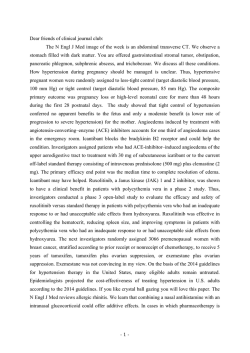

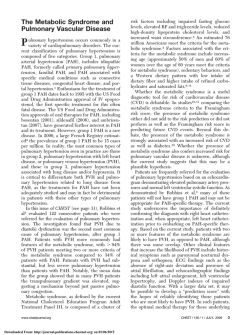
![Download [ PDF ] - journal of evolution of medical and dental sciences](http://s2.esdocs.com/store/data/000475167_1-3fd66abd823a299e32f0bb1f6c6f6a60-250x500.png)
